Archived Water Damage Blog Posts
Take Steps to Prevent Plumbing Leaks
7/10/2023 (Permalink)
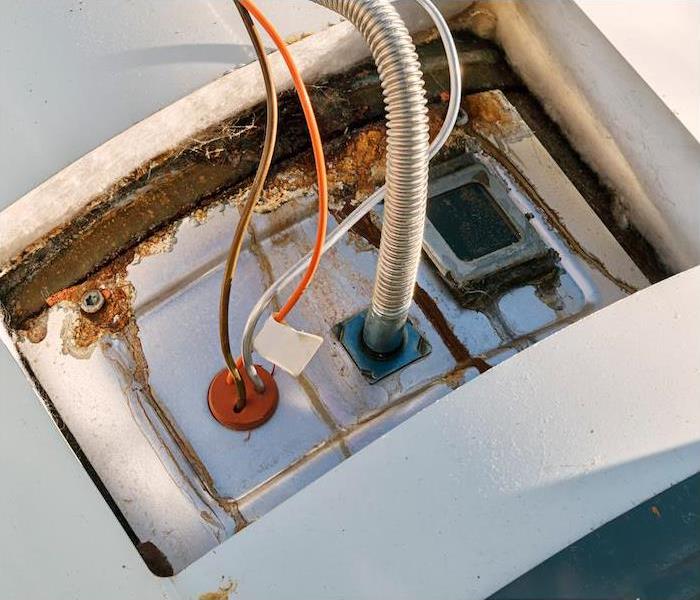 SERVPRO of Gordon, Murray, & South Whitfield Counties can help at the drop of a hat when you experience any water emergency.
SERVPRO of Gordon, Murray, & South Whitfield Counties can help at the drop of a hat when you experience any water emergency.
Plumbing leaks are no joke. They can spring up instantly and cause dramatic and costly damage before it can be brought under control.
In fact, the average household in the U.S. experiencing a leak loses 10,000 gallons of water per year—with over 1 trillion gallons nationwide combined yearly! While no one knows whether there is going to be an accident, there are still numerous methods to decrease the chance of a costly plumbing leak in the house.
By maintaining your plumbing, you can lower the risk of a plumbing leak and reduce the damage if one happens. Let’s consider what areas you can regularly inspect and maintain to prevent water damage in the home:
Appliance Water Supply Lines. Every appliance that uses water has water supply lines that are generally made up of plastic or metal tubing. As a result, it is critical to monitor these lines on a regular basis. Keep an eye out for corrosion, discoloration of the pipe itself and the flooring and walls around it, as well as calcium buildup in the supply line. One common modern preventive measure would be to consider upgrading to flexible stainless steel when replacing these lines.
Water Heater. Be sure to follow the maintenance instructions on your water heater carefully. A water heater can burst due to old age and devastatingly flood the room around it in minutes, potentially causing severe and costly damage to your home. A water heater should be inspected by a professional plumber every few years, and if it’s in a location where a leak would be truly devastating, consider installing a leak detector.
Drains. All sinks, disposals, showers, tubs and toilets should be consistently maintained and clean of debris. Make sure that you and other family members are aware of what should and should not be flushed or poured down the kitchen sink. Additionally, if you have a family member that is an over-consumer of toilet paper, consider installing a bidet to prevent build up in your pipes.
Finally, if a leak has sprung out of control, it’s important to know where the main water valve is and how to shut it off. It’s essential that everyone in the home is aware of how to shut the water main line off in the event of an emergency, considering you never know when the emergency can happen.
SERVPRO can help at the drop of a hat when you experience a water damage emergency. Call the experts at SERVPRO of Gordon, Murray, & South Whitfield Counties. We are available 24⁄7 to respond immediately and get the job done professionally.
Water Damage in Your Bathroom
6/23/2022 (Permalink)
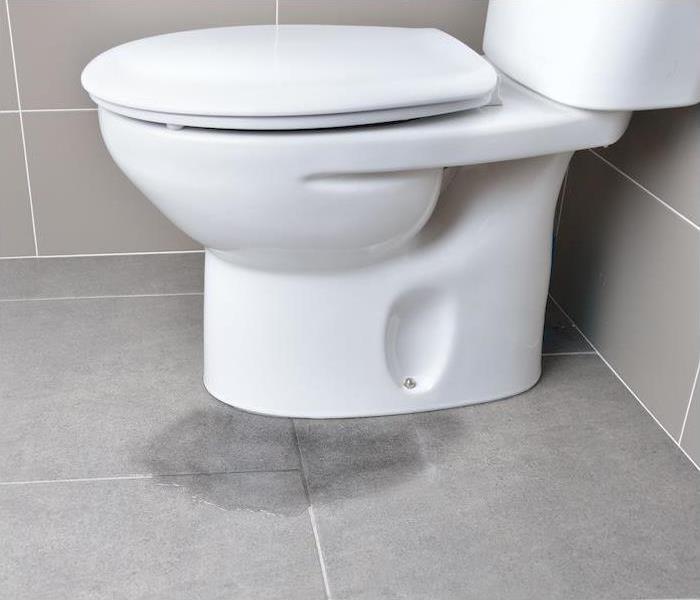 Should you experience any water damage, call SERVPRO of Gordon, Murray, & South Whitfield Counties, We are available 24/7.
Should you experience any water damage, call SERVPRO of Gordon, Murray, & South Whitfield Counties, We are available 24/7.
Because bathrooms use a lot of water, it’s likely that some of that water may seep into the walls and flooring, producing water damage. And if you’re not careful, you might wind up with damage that requires considerable and costly efforts to restore.
In fact, the average cost of bathroom water damage repairs is over $3,000 in the U.S.
While there is always a potential that water can cause damage in your bathroom, if you follow these easy steps, you can avoid costly water damage. Prevent water damage to your bathroom by following the advice below.
Check for Leaks. Check for symptoms of leaks on a regular basis, such as discoloration or soft spots on walls or floors as well as musty odors. Test the walls and floors by pressing in to them to see whether certain places are softer than others. Look for leaks under vanities and around the shower or tub and verify that there isn’t any leaking. If any of these issues occur, track out the source of the leak and get it repaired.
Ensure Proper Sealing. Properly sealing areas of your bathroom that could otherwise allow water to leak out into your walls and flooring can make all the difference when it comes to preventing damage to your bathroom. Prevent water from leaking behind walls and under floors by replacing broken, damaged or missing tiles in your shower, flooring and backsplash. In the same way, ensure your sealing is fresh and working properly. Replacing cracked or failing grout and caulking around sinks, tubs and showers with a silicone-based bathroom-grade caulk can make all the difference in water-proofing your bathroom.
Continually Inspect Your Bathroom. Maintain your leak-free bathroom by regularly checking the floor and walls for water after showering or bathing, drying or removing it immediately if there happens to be any. Additionally, don’t let any water stay standing in the shower or tubs by draining it completely. This helps to prevent the harm that standing water might cause.
SERVPRO has the expertise to assist you with all forms of recovery from water damage. When you discover water damage in your bathroom, call the experts at SERVPRO of Gordon, Murray, & South Whitfield Counties. We are available 24⁄7 and seven days a week, including all holidays because disasters don’t wait—and neither do we.
Do you need a sump pump?
6/7/2022 (Permalink)
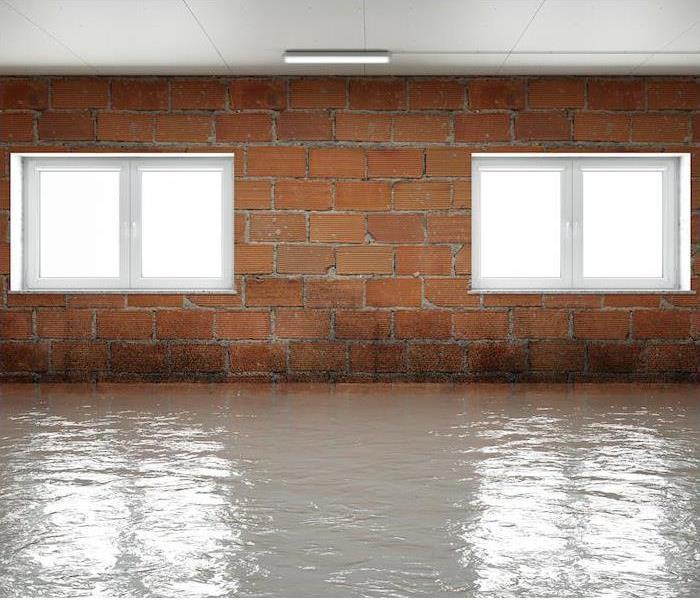 Call the experts at SERVPRO of Gordon, Murray, & South Whitfield to get you back to dry. We are on call 24/7 to take care of any immediate need.
Call the experts at SERVPRO of Gordon, Murray, & South Whitfield to get you back to dry. We are on call 24/7 to take care of any immediate need.
You may have heard of someone talking about their sump pump after heavy rain. Perhaps they were talking about how if it weren’t for their sump pump, their basement would have flooded, costing them big-time in damages.
Let’s take a look and see if a sump pump is right for you and your property.
WHAT IS A SUMP PUMP?
A sump pump is a device that can be installed beneath your home’s lowest point, such as the basement or crawl space. This little but extremely useful tool can help prevent flooding.
The pump is always on standby, waiting to be activated. When the soil surrounding your home gets oversaturated after a heavy rain, excess water flows toward the sump pit, which fills up with water.
The sump pump is activated, and the pump is turned on, removing water from the pit and draining it away. A sump pump prevents the groundwater from rising above the level in which it is installed, preventing flooding. In many ways, sump pumps are essentially immediate flood insurance.
SHOULD YOU INSTALL A SUMP PUMP?
There are many advantages to installing sump pumps if your property needs one. Let’s take a look at the following and determine if you should install a sump pump at your property:
- If you live in a region where there is significant rain and/or snow. Here in Georgia, flooding from storms of different kinds are very common, especially throughout the spring and summer seasons. It’s very common to see basements in this area flood after these storms.
- If your house is in a floodplain, you will want to consider a sump pump. Groundwater levels are more likely to rise after heavy rains, snowstorms and spring runoff in areas with poor drainage and lower elevation properties in valleys surrounded by higher elevation hills.
- If your basement has previously flooded, it is a good idea to install a sump pump, as it’s likely it won’t be the last time.
- If you’ve finished your basement, consider installing a sump pump to safeguard your living space and protect carpeting, furniture and other items in your underground living space from flood damage.
If your basement floods, call the experts at SERVPRO of Gordon, Murray, & South Whitfield Counties to get you back to dry quickly and professionally. We are on call 24⁄7 to take care of your emergency immediately.
The 411 on Commercial Water Damage Prevention
4/11/2022 (Permalink)
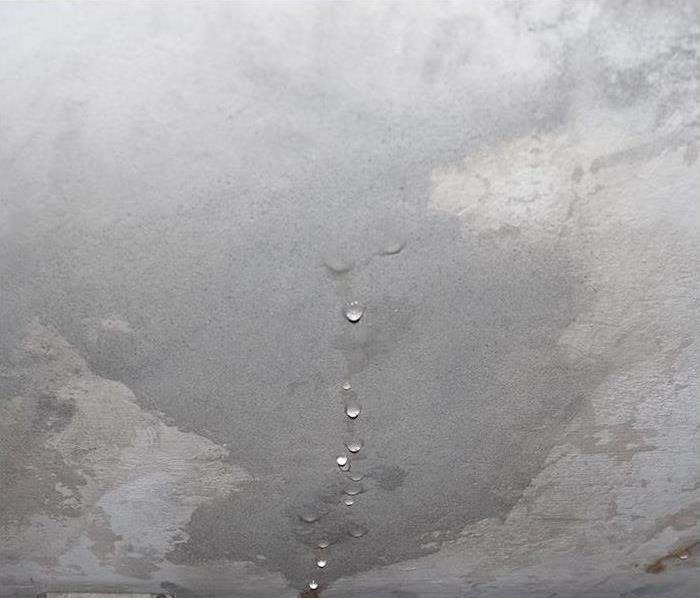 If your business is affected by water damage, reach out to your local restoration expert SERVPRO of Gordon, Murray, & S. Whitfield.
If your business is affected by water damage, reach out to your local restoration expert SERVPRO of Gordon, Murray, & S. Whitfield.
Water damage is often unanticipated and comes in all shapes and sizes, whether it is caused by a flash flood, a burst pipe or a leaky roof. No matter if it is pooling water in your ceiling that can go unnoticed or you’re standing in water up to your knees, water damage can cause significant untimely and costly interruptions to your operations.
In many circumstances, however, preventive measures can be taken to avert severe delays or property damage. The following are a few recommendations to inspect and prepare you in protecting your facility from water damage:
Check for plumbing issues. One indicator of plumping issues could be if you’ve observed a substantial increase in your water bill, a pipe or plumbing equipment is almost certainly to fault. You can check your walls, floors and ceilings for indications of leaks. Discoloration or mildew development is also a reliable indicator that a pipe is damaged or leaking. Whatever you discover, be certain to get it repaired as quickly as possible.
Install a water-sensing device. You can find water sensors available at practically any home improvement store. The devices provide alerts or alarms in the case of a water leak, allowing you to contain the damage and respond quickly. The majority of sensors may be connected to your smartphone or integrated with your facility’s security system, enabling you to get alerts even while you’re not on-site.
Look at the windows and doors. Water making its way indoors from outside during storms or rain is another frequent cause of water damage. Examine the area surrounding your windows, doors and any other exposed locations. Be sure to reseal any gaps or cracks using caulking that is waterproof. Additionally, refinish window or door trim to provide additional protection against decaying seals and trimming.
Regularly inspect the roof. Have an expert inspect your roof to discover places that might leak. Different types of roofing may need different treatments such as sealing on a regular basis to provide an additional layer of protection. Additionally, remember to clean the gutters to ensure that rainfall flows easily away from the roof. Take note of locations that are prone to drainage problems. Along the outside your building, be sure to look for spots that may be prone to water accumulation if the ground gets too wet. Consider getting the help of a landscaper or drainage specialist to do an inspection of the area and provide proper draining.
If your business is affected by water damage, enlist the help your local experts at SERVPRO of Conyers/Covington. We are here to help 24⁄7 whenever disaster might strike.
The Sights, Smells, and Sounds of Water Damage
4/9/2022 (Permalink)
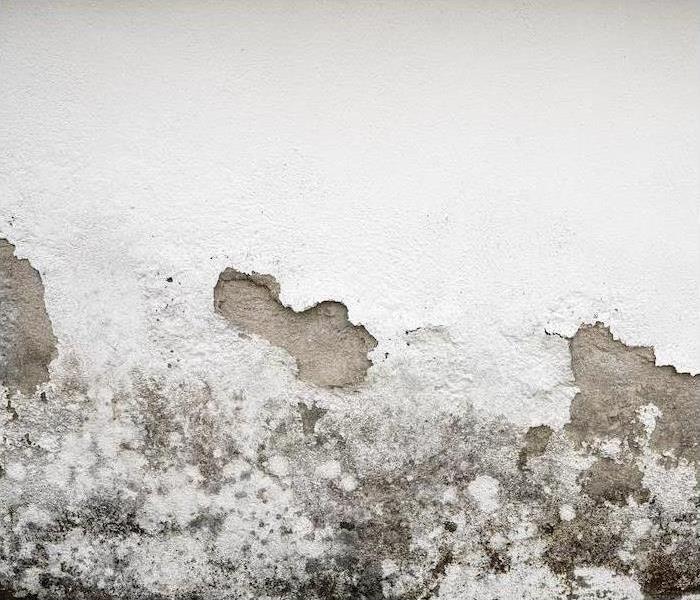 ?If you suspect water damage in your home, call SERVPRO 24 hours a day.
?If you suspect water damage in your home, call SERVPRO 24 hours a day.
Water damage can hide for a little while before revealing itself in your home, but it can only hide for so long. Depending on the type and location, it may be a matter of a few minutes, hours or days before you notice something’s going on, but eventually the water will collect itself somewhere or affect something you can’t help but notice.
Let’s look at the most common ways you can catch a leak in the act, and hopefully put a stop to it before it becomes a full-blown problem.
Spots. They call those fraud protection overlay images “watermarks” for a reason. One of the absolute telltale signs of water damage is noticing dark or wet spots on your ceiling or walls, both indicative of a leak from above. These can let you know there’s a problem on the roof or in the attic, or something happening with a pipe inside the wall.
Paint or drywall that flakes or bubbles. Paint can’t cover a water leak for long—eventually it will show in the form of cracking, bubbling or flaking. And drywall will expand, crack or otherwise fluff up as it becomes damp. (It will also weaken significantly.)
Puddles and pooling water. You clean up a puddle in the floor or under a cabinet, or you dry a wet spot in the carpet, only for it to come back. Uh oh. There’s something under there causing water to pool up and seep through.
Running water sounds. Like we said, water leaks can hide for a while before they become visible. But a keen ear in a quiet moment might help you catch something going on. Be on the listen-out for the sound of running water inside the walls when no plumbing is in use. You should also heed sounds like bubbling, gurgling or whistling from your water heater or plumbing in general.
Moldy smell. A musty, pungent odor can be a dead giveaway that moisture has gotten out of control or that water damage is evident in a basement or bathroom. If you catch that signature smell, mold is already growing and you need to take action.
Your utility bill. If your home doesn’t tell you about hidden water leaks, your utility bill may. If you notice an uptick without explanation, it could indicate a hidden leak—for example, a puncture or root invasion in an underground pipe that could lead to serious foundation problems.
If leaks lead to water damage, you’ve got a friend in the restoration community. Call SERVPRO to get yourself safely back in the dry.
How Does Water Damage Lead to Mold?
3/14/2022 (Permalink)
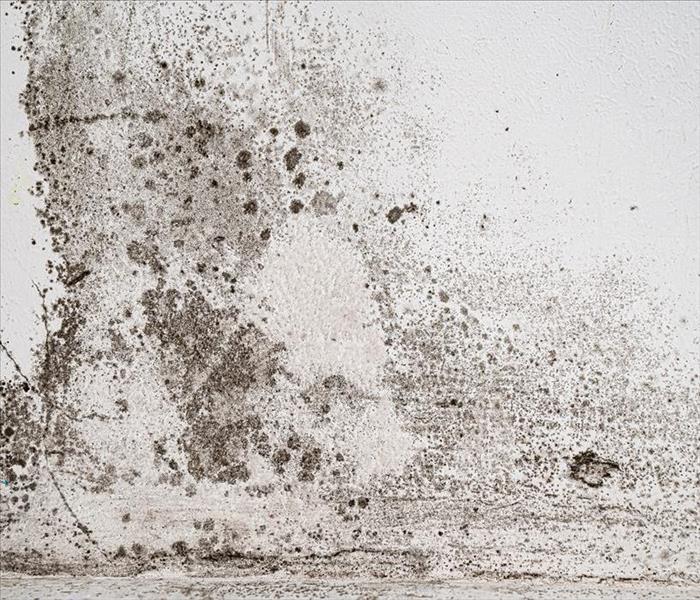 If mold invades your home, call SERVPRO of Gordon, Murray, & S. Whitfield today!
If mold invades your home, call SERVPRO of Gordon, Murray, & S. Whitfield today!
Water damage is something that no homeowner ever wants to experience, but unfortunately, it is a rather common occurrence. Between hidden leaks that can pop up in your plumbing system, water seepage in crawl spaces or surprise roofing issues, there are lots of ways that water damage can pop up in a home.
While water damage is an inconvenience, it can lead to an even more pressing concern: mold growth. Mold growth thrives in damp places, so any time water works its way into an area it should not be in, there is a high chance that mold will find its way there as well. Below, we will look at why mold and water damage are so closely related so you can be on the lookout for any signs of growth.
Why Water Damage Often Leads to Mold
**Mold loves humidity.** The nature of water damage can vary, but in incidents where there is flooding or general dampness in an affected area, the humidity levels can get rather high. Basements, laundry rooms and bathrooms can all turn into very humid areas, which can create the ideal environment for mold to take hold. Ideally, the humidity in an area should stay below
50% at all times in order to discourage mold growth.
**Mold spores need moisture to grow.** Many people are surprised to learn that mold spores are everywhere—in nature, mold aids with the decomposition of organic material, and its spores spread via the air. Therefore, mold spores are always floating around looking for an ideal place to land, which is how they wind up in homes (often after hitching a ride on clothes, shoes or pets). However, mold spores require moisture to grow, so while they may work their way into homes, if they cannot find an area with moisture that they can grow, they will not be able to
reproduce.
**Mold grows well in contaminated waters.** Oftentimes, water damage is caused by water that is not necessarily clean, such as rainwater or floodwater. Mold can grow especially well in these types of waters because of all the bacteria that is already present, making water damage of this type especially susceptible to mold growth.
*If you are curious about how mold remediation works, we are here to help. Contact us today to learn more about our remediation services or to report mold damages.*
What Conditions Are Right for Mold to Grow?
3/8/2022 (Permalink)
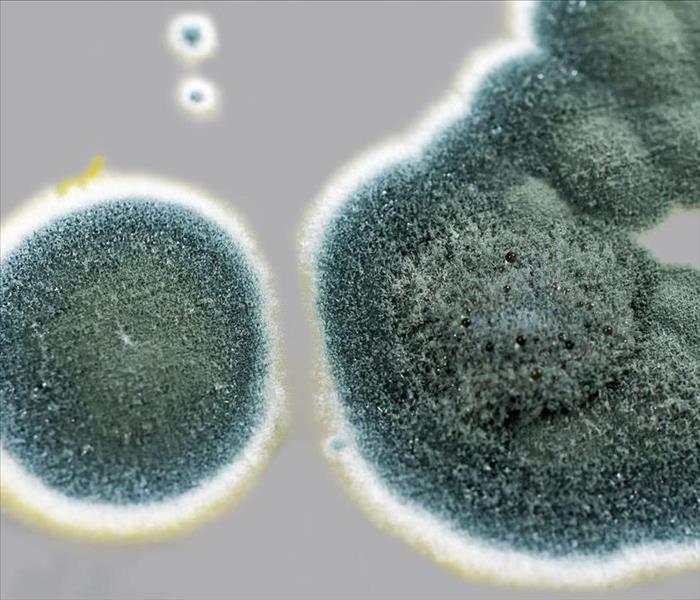 Mold can make you feel sick. Call SERVPRO of Gordon, Murray, & S. Whitfield if you have mold in your home.
Mold can make you feel sick. Call SERVPRO of Gordon, Murray, & S. Whitfield if you have mold in your home.
Mold growth is a complicated issue for homeowners to have to face. While mold can only grow if the conditions are right, there are many instances where this is the case—and once mold establishes itself, it is extremely difficult to fully get rid of it without professional help with the remediation process.
Fortunately, the conditions where mold is likely to grow can be abated in most instances. Because prevention is so important when it comes to mold management, today we will be looking at the conditions that are ideal for mold to grow and how they can be prevented.
The Conditions That Mold is Likely to Grow In
**Warm, humid conditions.** Mold requires moisture to grow, but it does not always have to be standing moisture that allows it to start its process. Humid areas, such as bathrooms, basements and laundry rooms, are prime candidates for mold growth in the home. When the air in an area becomes saturated with humidity, it can lead to high moisture throughout the room which can allow mold to become established.
**Poorly ventilated areas.** Mold spores are spread via the air, so when areas are poorly ventilated, it is much easier for mold to settle in one spot and begin to reproduce. This is doubly concerning as areas with poor air circulation are also typically areas with high humidity, which can create an even more ideal environment for mold spores to land in. Installing fans or other types of air flow system in areas without much ventilation is a great way to prevent mold.
**Any area with untreated moisture damage.** Mold will often establish itself around water damage, as it thrives on moisture. Any area that has a buildup of moisture is ripe for mold growth, which means hidden leaks are often first identified by the signs of mold around the area. This is why it is so important to have water damage abated quickly and professionally when it occurs, because the longer it is left untreated (or if it is untreated properly), the worse a mold problem is able to become.
*If you are in need of mold remediation or would like to learn more, we would love to help. Contact us today to learn more about our mold remediation services!*
What Types of Places Are Likely to Attract Mold Growth?
3/3/2022 (Permalink)
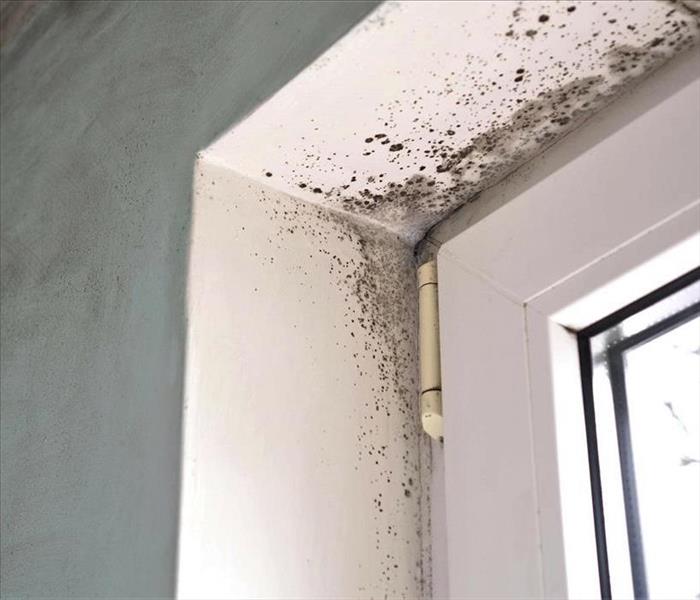 If mold invades your home, call SERVPRO of Gordon, Murray, & S. Whitfield to evict it!
If mold invades your home, call SERVPRO of Gordon, Murray, & S. Whitfield to evict it!
Mold growth can be a frightening thing for homeowners to deal with. It is an insidious and stubborn problem that can cause significant damages if not treated quickly and professionally by mold remediation experts—but how do you know if you are at risk of experiencing mold growth?
One of the only positives about mold is the extremely specific conditions that it needs to grow. Mold is only likely to be found in a few places where the environment is right for it to be able to take hold.
Below, we will be taking a look at what these places are so homeowners know exactly where to keep their eye out for these harmful spores. Preventing mold and treating it quickly when it does arise is the best way to stop the issue from getting out of hand.
The Places Where Mold Is Likely to Grow
**In bathrooms and laundry rooms.** Mold thrives in areas with high moisture content, so anywhere that experiences regular and high humidity—such as bathrooms and laundry rooms—is likely to be a haven for mold. Establishing consistent airflow and mitigating the humidity in these areas can go a long way in preventing mold from ever growing in these places.
**In basements and crawl spaces.** Basements and crawl spaces are often popular spots for mold to be discovered because of how ideal their conditions are. Not only is humidity typically high in these areas, but they are also often dark and may even experience water damage from ground seepage if they are not properly weatherproofed. Dank odors and condensation in these areas are often a sure sign that mold is likely to take hold.
**In areas that have experienced water damage.** Water damage is a serious issue for several reasons, including the fact that it is likely to give rise to mold growth if it is not treated properly. Whether the water damage is from a hidden leak in the plumbing system or a flooding issue, it is important that it be addressed quickly by water restoration professionals to completely remove the moisture and ensure that mold is not likely to become a lurking threat.
*If you are in need of mold remediation, water damage restoration or would simply like to learn more, we are here 24/7 to help. Contact us today to learn more about our services.*
The 3 Toxicity Levels of Water Damage
2/2/2022 (Permalink)
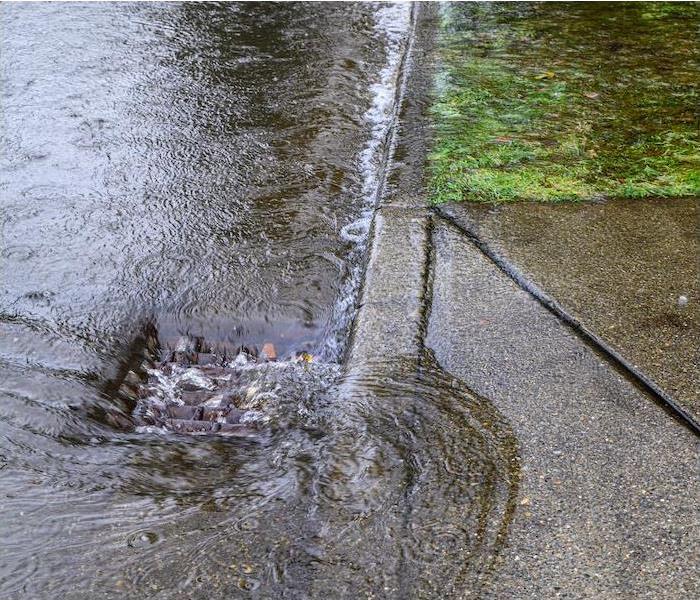 No matter the water damage, we can quickly set things right. Contact the SERVPRO of Gordon/Murray/South Whitfield team to learn more.
No matter the water damage, we can quickly set things right. Contact the SERVPRO of Gordon/Murray/South Whitfield team to learn more.
Water damage can happen all sorts of ways, and it can certain cause myriad problems, not the least of which is its potential for toxicity. But how do we determine which water sources are toxic and which aren’t? Why isn’t it safe to touch or swim in floodwater, but rain is fine—aren’t they the same?
These distinctions are very important, and there’s a governing body called the Institute of Inspection, Cleaning and Restoration Certification that helps us understand them.
Category 1: Clean Water Damage
Damage from so-called “clean” water is the least worrisome kind of damage, and assumes a certain level of cleanliness from its sources—typically things like refrigerators, water supply lines for appliances or even showers.
The nature of this type of damage means most of the damage mitigation involves simple drying, extracting and dehumidifying, and most instances of clean water damage don’t create health worries.
Category 2: Grey Water Damage
The next category is referred to as “grey” water. The sources of grey water include sources that aren’t inherently or necessarily toxic, but that could or may be—overflow from toilets, backups from an unfiltered sump pump, or even leaks from a washing machine which could have been holding toxic materials during the wash cycle.
Touching water from these sources may not cause immediate harm, but grey water is still to be avoided as it could cause potential danger all the same
“Black” water is the nasty stuff. It carries an immediate, inherent risk of toxicity, and it requires immediate action for removal to get these risks mitigated. Sewer backflows, broken toilet bowls containing fecal matter and other septic water fall into this category.
It may surprise you, but overflowing ground and river water fall into this category, as does flood water, because they may contain everything from waste to lawn-care chemicals and parasitic organisms. Black water can cause health effects, and affected surfaces like carpet or sheetrock must be removed. This water is also the most difficult to deal with in the aftermath, because it requires such care in cleanup.
No matter the water damage or the level of toxicity or danger to your home or family, we can quickly set things right. Contact your local SERVPRO team today to find out how we can tackle water problems of any size or nature.
So You’ve Got a Sewage Backup
2/2/2022 (Permalink)
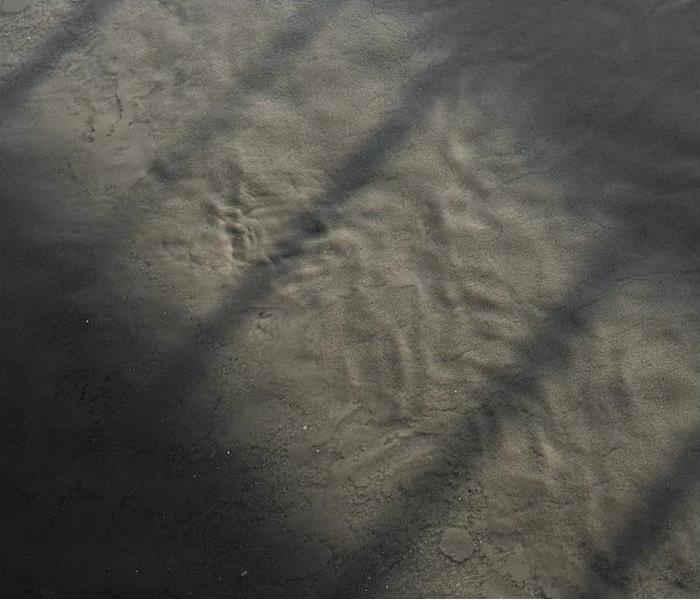 Sewage backup can be a serious problem, reach out SERVPRO of Gordon, Murray, and South Whitfield to learn more.
Sewage backup can be a serious problem, reach out SERVPRO of Gordon, Murray, and South Whitfield to learn more.
Water damage can be rough stuff in any form. Burst pipes, flooding and appliance issues all create difficult situations in their own right. But a sewage backup can be an entirely other level of both nastiness and danger.
Sewer problems can be the result of civil sewer systems that have aged past their primes, tree roots growing into sewer lines or blockages of a sanitary sewer main. Regardless of the cause, however, one thing is clear (or literally probably not clear at all)—sewer backups introduce toxins into your home, and they leave a difficult cleanup job in their wake.
When you find yourself faced with sewer damage, here are some things you should do immediately upon discovering the damage to ensure your safety and get things under control until your local SERVPRO team arrives.
Evacuate anyone vulnerable from the area. This includes seniors, children, even pets—anyone who may suffer more readily from the toxins sewage can introduce into your home’s atmosphere. Keep them safely away from the backup area until restoration is complete.
Shut off your main water supply and electricity if it’s safe to do so. If you can get to your power panel and water main safely, use them to stop the flow of water and decrease the odds of your water backup causing an electrical fire. Don’t do this if your electrical panel is under water, or if you would have to stand in water to turn it off. If you can’t safely shut off your own power and water, call your utility companies and have them do it.
Open windows in the affected area to encourage ventilation and get some fresh air flowing in.
Document your situation and take lots of photos for your insurance company. Be sure to include any items that have sustained damage, as these will be important for your insurance claim process.
Add a little bleach to standing water, if you can do so safely, so that the chlorine in it can do some disinfecting work and prevent the spread of bacteria. Don’t touch stained or affected areas, and don’t come in contact with what could be very dangerous water.
Don’t forget to call SERVPRO. We’ll be there quickly, get things cleaned and managed thoroughly, and we can work with your insurance company on your behalf.
Regardless of the cause of your sewage problem, SERVPRO has the tools and techniques to make it “Like it never even happened.”
Sewage backup is a serious problem, but we can take care of it and restore your home after the damage. Contact SERVPRO anytime to get the pros on your side.
The So-Called 100-Year Flood
2/2/2022 (Permalink)
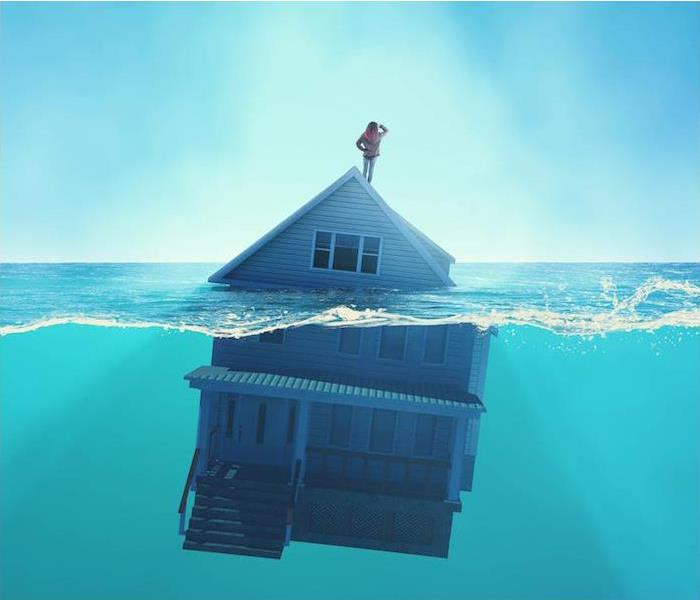 If flooding or other water damage cause trouble for your home or business, contact SERVPRO of Gordon, Murray, & South Whitfield counties.
If flooding or other water damage cause trouble for your home or business, contact SERVPRO of Gordon, Murray, & South Whitfield counties.
Flood probability is based on a number of factors, and scientists and engineers use a specific set of criteria to determine the likelihood that rivers may flood in heavy storms. Flooding can happen wherever it rains, and it can cause troubles like 2019’s sudden troubles in Conyers; but there’s a certain term on which much of our flood conversation hinges: the “100-year flood.”
It’s a rather foreboding term, one that definitely makes the listener aware that it’s something to be concerned about. But what exactly is it? Is it a general term, or are there actually 100-year floods we can measure and predict?
First, a 100-year flood is a very real, scientific measurement, as opposed to a general declaration like, say, a gullywasher or deluge. Without getting overly technical, a 100-year flood is, in theory anyway, a flood that statistically should only occur about once every 100 years.
In other words, based on data from nearby rivers, bodies of water, elevation levels and other factors, a 100-year flood is a flood that has a 1% chance of occurring in any given year.
This kind of flood is also known as a 1% Annual Exceedance Probability (AEP) flood.
So, does a 100-year flood only occur every hundred years? Well, yes and no. While the average space between them typically does meet that criteria, that doesn’t preclude the possibility of two 1% floods happening in back-to-back decades, years, or even months.
Flooding is unpredictable, but statistically speaking, the 100-year or 1% designation gives us a baseline for estimating the frequency and severity of a certain kind of flood.
Why does all this matter? Well, for one thing, aside from giving us a sense of how bad a flood was or could be, and how likely it may be to occur again, the 1% AEP flood is the basis for the National Flood Insurance Program, which, among other things, requires homeowners within high-risk flood zones to carry flood insurance.
So you can see why it’s important that we have both accurate flooding data and analysis as well as risk prediction. The accuracy of the portrait and prediction of 100-year floods could impact whether your home sits in a high-risk zone or not.
The 1% analysis also helps us plan things like infrastructure, drainage and building needs for flood plain areas.
The last 100-year flooding in our area came in the form of massive floods in September 2009, which resulted in half a billion dollars in damages, and actually reached the 500-year flood designation in some areas, meaning there was only a 0.2% chance of that flood occurring that year in this area.
Flooding isn’t inevitable, but it’s always a possibility when heavy storms overwhelm bodies of water or drainage systems. If flooding or other water damage cause trouble for your home or business, contact SERVPRO for fast, complete cleanup and recovery.
5 Places to Check After a Hard Rain
2/2/2022 (Permalink)
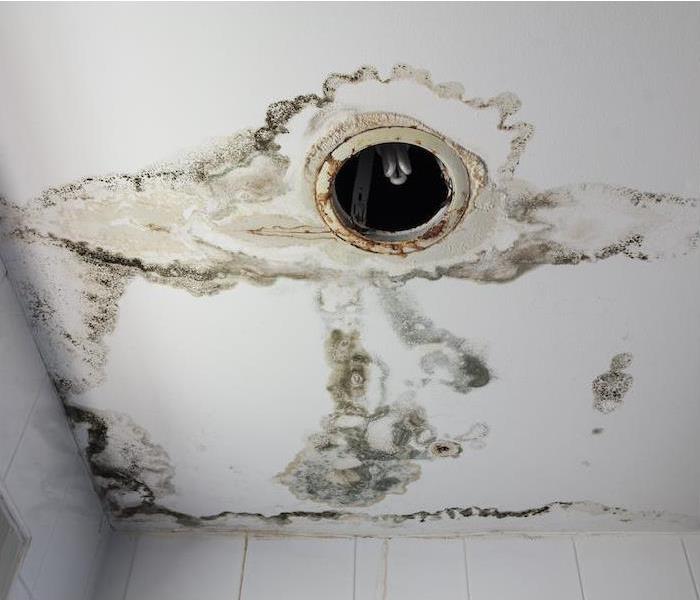 Water damage can come from a number of places. If you find any signs of damage to your property, call SERVPRO of Gordan, Murray, & Fort Valley.
Water damage can come from a number of places. If you find any signs of damage to your property, call SERVPRO of Gordan, Murray, & Fort Valley.
We get plenty of rain in the Fayetteville area. The national average for a given city is 38 inches of rain per year, and we beat that average that by more than 10 inches.
Now some of that rain courtesy of your standard, near-daily summer shower. But some of it, as you well know, comes from storms that pack quite a bit more punch.
As a homeowner, it’s incumbent upon you to protect your home as much from water damage as much as possible, or at least to stop it once it’s discovered. So after a heavy rain, here are the places you should check to make sure all is well.
Check your basement. If there’s one solitary place you can anticipate water damage at home, it’s the basement. Homes with basement have a 98% chance of experiencing excess moisture or flooding at some point, so check here first. If you see water pooling, paint bubbling or you smell a damp odor, you may have an issue.
Crawlspaces and attics. Much like the basement, these areas can become inundated with moisture. If you have a crawlspace instead of a basement, it’s subject to the same kind of moisture issues, and attic moisture can reveal to you that there’s a leak somewhere in the roof.
Check on your sump pump. Your sump pump works hard to move water away from your house during a big storm. You should test your pump quarterly, or after any major rainfall.
Examine your gutters. Your gutters catch more than rain, and there are plenty of ways for them to get clogged or even damaged. In particularly heavy rains, gutters can be overwhelmed by water flow, and that becomes even more likely if they are obstructed due to built-up dirt, granules from roof shingles, twigs and leaves.
Inspect your roof. You don’t have to get up on a ladder every time it rains, but after a heavy storm, particularly if you have overhanging tree branches, take a good look at your roof from the ground. If you notice anything that looks off—broken or warped shingles, unfastened flashing or gutters that seem out of place—call a professional to conduct a full examination.
Water damage can come from a number of places at home. If you find a source of water leakage has done harm to your property, call your local SERVPRO for fast, expert help.
Do You Know What Pipes Are Vulnerable to Freezing?
1/14/2022 (Permalink)
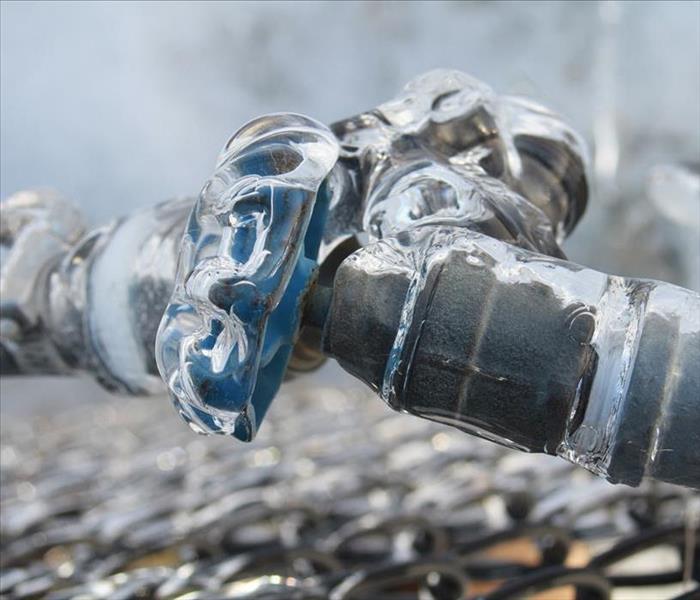 If you have water damage due to frozen pipes, contact SERVPRO of Gordon, Murray, & South Whitfield Counties today.
If you have water damage due to frozen pipes, contact SERVPRO of Gordon, Murray, & South Whitfield Counties today.
Experiencing winter weather can certainly be an inconvenience. Between cold temperatures and high winds, it is not a season designed for comfort. However, when things turn frigid, there is also cause for concern regarding the pipes in your home.
While frozen pipes may seem like a problem that only occurs in the chilliest of places, depending on your home’s construction and insulation levels, it is still a real possibility here, too.
According to the Insurance Information Institute, water damage and freezing makes up over 23% of homeowner insurance claims in the United States. While instances of water damage due to frozen pipes may be covered on your insurance, it is still a headache that is better avoided when possible.
Below, we will look at the pipes in the home that are most vulnerable to freezing so you can be certain you know what to look out for.
The Pipes in a Home That Are the Most Vulnerable to Freezing
Pipes along exterior walls of the home. Depending on your home’s layout, plumbing can be routed through the walls in a variety of ways. Plumbing for the interior is commonly routed through exterior walls, and if you have outdoor spigots on your home, these pipes are also exposed to more of the exterior temperatures. When things get rather cold, these are typically the first pipes to freeze.
Pipes in the attic, crawlspace or basement. If you have an attic, crawlspace or basement that is not insulated, it is important to note if you also have plumbing in these areas. If you do, know that these pipes are also prone to freezing if it were to get cold enough. These pipes are rarely routed close to a home’s insulation, so they may be extra exposed.
Any home in a southern climate. While we may think of frozen pipes as a problem that only occurs in the cold of the northern half of the country, it is very likely for homes in the south to experience frozen pipes, too. Pipes in the south are rarely insulated heavily, so when we do get a cold snap, they are likely to be impacted.
If you have water damage due to frozen pipes, we can help. Contact us today to learn more about our water restoration services.
Signs Your Pipes May Be Frozen
1/10/2022 (Permalink)
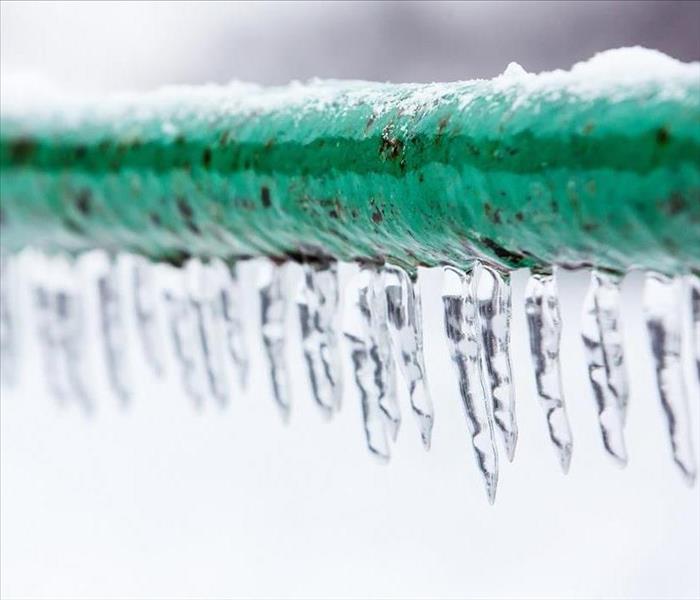 If you have water damage due to frozen pipes, Contact SERVPRO of Gordon, Murray, & South Whitfield Counties today.
If you have water damage due to frozen pipes, Contact SERVPRO of Gordon, Murray, & South Whitfield Counties today.
Having the pipes in your home freeze is far more than simply an inconvenience. While you may not be able to use the taps in your house while the pipes are frozen, they can also burst and lead to serious water damage throughout your home.
In fact, the Insurance Information Institute has found that 23% of all the homeowners insurance claims made in the United States are related to water and freezing.
While we tend to think of pipes freezing as something that happens in extremely cold climates, any time the weather falls below 32 degrees Fahrenheit, it is possible for pipes to freeze. Understanding what signs to look for is key for knowing if your pipes are frozen—and if you notice them, acting quickly is a must to avoid costly damage.
Below, we will look at a few key signs that may indicate that you have a frozen pipe on your hands so you can take action right away.
Signs That the Water Pipes in Your Home Have Frozen
No water is coming out of the taps. If you turn on a faucet or tap in your home and do not get water as usual, that may be a sign that your pipes are frozen. Frozen pipes may result in no water flow at all, or they may cause only a trickle to come out of the faucet—regardless, experiencing this is certainly cause for concern.
You experience an odd odor from your tap or drain. If you have an odd odor in your home, and it seems to be coming directly from a drain or tap, that may mean the pipes have frozen. If there are odors in the pipe that are blocked by ice, they will not be able to escape as usual, and will only be able to travel back the way they came.
There is frost on your pipes. If you have pipes that are exposed in your basement, crawlspace or attic, you can check for frost on them if you suspect they may be frozen. Any time frost has accumulated on the outside of a pipe, that is a good indication that you have a full or partial freeze on your hands.
If you have water damage due to frozen pipes, we can help. Contact us today to learn more about our water restoration services and how we can help you.
Why Your Home Needs to Be Dried After Water Damage
12/29/2021 (Permalink)
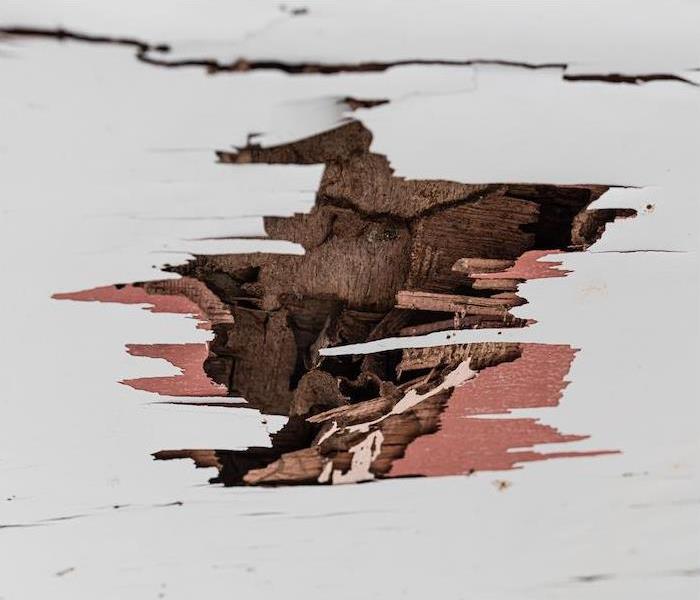 When water damage strikes at home, choose SERVPRO of Gordon, Murray & South Whitfield Counties for safe, thorough restoration.
When water damage strikes at home, choose SERVPRO of Gordon, Murray & South Whitfield Counties for safe, thorough restoration.
If you’ve never experienced water damage at home, consider yourself fortunate (especially if you have a basement, but that’s for another blog.) Water damage is one of the most common issues for homeowners, and it causes a massive $13 billion in damages each year in the United States alone.
That’s a lot of water coming into homes, doing all sorts of damage—ruining carpets and subfloors, soaking furniture and drywall, even causing rot in wood framing and mold just about everywhere. And while you may be able to get rid of some of it in the short-term with a wet/dry vac or a sump pump, you’d be amazed at how much is still there. You can rid yourself of much of the water, but the leftover moisture can really cause a lot of trouble.
Here’s why you should call SERVPRO to do a total drying of your home after water damage.
You can’t see what you can’t see. Your basement, carpet or other area may look dry to the human eye, but there are elements of moisture you can’t see. Fibers, woods, cracks and crevices are hiding dampness that need removal in order for the drying process to be complete.
We’ve got more than eyeballs—we have instruments and methods specifically designed to accurately measure the moisture levels in your home after a water event, plus the heavy-duty tools to rid you of it.
Mold is growing, and it’s not healthy for you to try and clean it. In fact, “cleaning” mold areas often leads to further mold growth, because your cleaning methods are spreading spores you can’t see all over. Even your shoes are carrying mold spores through your home.
Mold growth starts in as little as 24 to 48 hours, and it’s very hazardous to your health. The only way to stop mold is to get rid of the moisture that allows it to grow, and the only way to truly dry your house out after a water event is for a professional to do it.
Flood water and black water are toxic. When flood waters come in or your sewer backs up, your house is now full of floating contaminants, and this stuff is not to be dealt with lightly. Your local SERVPRO team is equipped with proper protection and tools to deal with biohazard materials, and we can safely and properly deal with whatever may be living in that water.
When water damage strikes at home, choose SERVPRO for safe, thorough restoration. Contact us today to see how we can help.
Time Is More Than Money
12/26/2021 (Permalink)
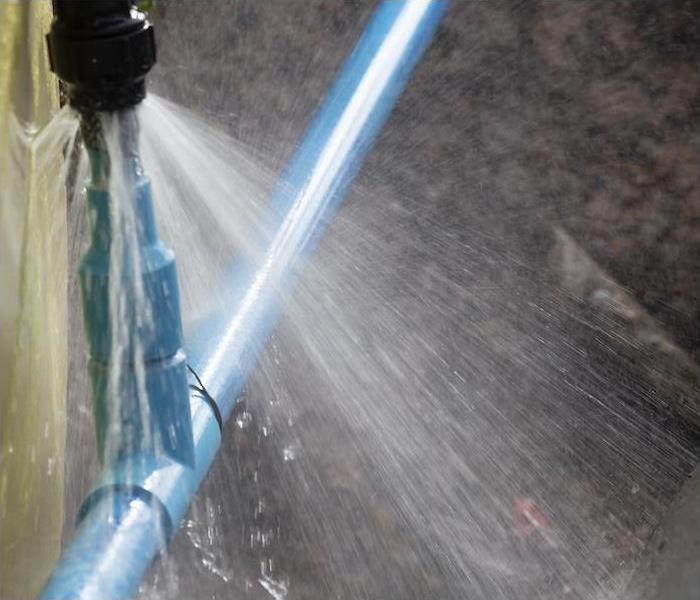 When water causes damage to your home or business, contact SERVPRO of Gordon, Murray & South Whitfield Counties for a quick response.
When water causes damage to your home or business, contact SERVPRO of Gordon, Murray & South Whitfield Counties for a quick response.
You know the old adage as well as we do: Time is money. At least since its 18th century usage by Ben Franklin, it’s been an aphorism used to convey the cost of slackness in one’s work, or the value of being diligent.
And it holds a kernel of truth. In many situations, waiting to act, work or adapt will cost you fiscally. And while this is also true when it comes to home repair, it doesn’t convey or reveal the full truth.
Time is indeed more than money. Time is damage.
When your home experiences a damaging incident such as a water line break or fire, it’s absolutely imperative that you act quickly, and that your service company does the same. That’s one of many reasons SERVPRO offers 24-hour emergency service—we know every minute spent waiting means a deeper, more destructive impact on your home, and more time you have to spend with your life upended from it.
After a fire, for example, your home will immediately be inundated with stains from soot—heavy discoloration of walls and objects begin right away, and only deepen the longer you wait. This damage becomes permanent in only a few days’ time, making it impossible to remove without completely rebuilding the walls.
Further down the line, your home could experience structural damage, warping and permanent smoke smell, not to mention the effect on your furniture, clothes and more.
When your home experiences a water damage emergency, the urgency is much the same, though the effect differ. Belongings, documents and furniture experience immediate damage, some of which is reversible if fast action is taken. But the longer things sit, the more permanent the damage becomes—drywall, sub-flooring, and belongings can all become lost, warped or rusted.
Then, of course, there’s mold. In only 24 to 48 hours, mold growth begins unless moisture is completely dealt with and extracted. Regular drying or removal of dampness won’t do—if you want to ensure the safety and sanitation of your home after water damage, complete extraction is necessary.
So you see, time in this case is much more than money, though it will cost more to undo the damage done to homes in which more time has passed. When an emergency comes, take advantage of the 24⁄7 care of SERVPRO of Gordon, Murray & South Whitfield Counties. We’re Faster to Any Size Disaster.
When water or fire damage your home or business, call on the industry leaders in restoration and recovery. Contact SERVPRO to get help now.
How to Find a Water Leak in Your Bathroom
9/21/2021 (Permalink)
 Every year, approximately one out of every 50 homeowners will file a water damage claim on their insurance.
Every year, approximately one out of every 50 homeowners will file a water damage claim on their insurance.
Do you know the signs of a water leak in your bathroom?
While sometimes an issue with a leak is obvious—and can cause major problems—there are subtle signs that are easier to miss. The good news is that you can find and repair leaks in your bathroom before they cause major issues to your home if you know what to look for.
Claims for bathroom leaks are part of the millions of water damage claims that are filed every year. On average, about one out of 50 American homeowners every year file a water damage claim. Many of them do it because of leaks in their home.
If you’re dealing with a water leak behind your bathroom wall or in any other part of your home, these tips can help you correct the problem before it becomes a more serious issue.
Dealing With a Water Leak Behind Your Bathroom Wall
Here’s what to do if you notice the signs of a water leak in your bathroom.
Know what you’re looking for. Signs of water leak in your bathroom can include water pooling on the floor, damp or stained drywall, or a musty odor. If you notice these signs, it’s time to start searching for your leak.
Check the usual culprits. You can test things in your bathroom to see if the leak is coming from common spots in your bathroom. That includes your sink, showers and tub. If you’re handy, you can do some of the work yourself. Otherwise, it’s smart to call in a licensed, trusted plumber to check out your bathroom and find the source of the leak.
Correct the issue. You’ll want to be certain the leak is fixed and that any resulting water damage to your home has been repaired. That’s the best way to protect your property and be sure that the damage doesn’t spread.
If you have water damage in your home due to a sewer backup, a burst pipe or another cause, you can count on us for restoration assistance. We have teams who are available 24⁄7 in the event of an emergency. Contact us at any time to learn more about our restoration services.
Do I Need Flood Insurance for my home?
8/25/2021 (Permalink)
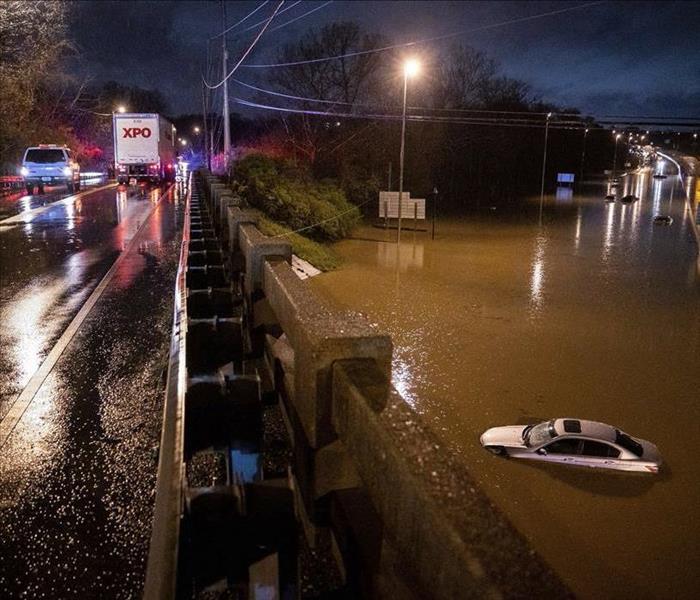 Do you have the right coverage for your home?
Do you have the right coverage for your home?
Standard homeowner’s and renter’s insurance does not cover flood damage. To protect your home, be sure to understand the risk of flooding and what your insurance options are. You will need flood insurance if you live in a designated flood zone. But flooding can also occur in inland areas and away from major rivers. Flood insurance is available for renters as well as homeowners, but a special policy required as flood insurance – like earthquake insurance – is not part of standard homeowner’s coverage. Flood policies are provided by the federal government and some private insurers. The federal government provides flood insurance through the National Flood Insurance Program (NFIP), run by the Federal Emergency Management Agency (FEMA). While they are underwritten by the government, NFIIP policies are generally sold through private insurance agents. In some areas, primary flood insurance may be available through private insurers. However, the NFIP provides only actual cash value coverage for your possessions. That means you’ll get the current value of your possessions, which may be considerably less than the cost you’ll incur to replace them, especially if they are older and have depreciated in value.
 SERVPRO of Gordon, Murray, & South Whitfield Counties can help at the drop of a hat when you experience any water emergency.
SERVPRO of Gordon, Murray, & South Whitfield Counties can help at the drop of a hat when you experience any water emergency.



 24/7 Emergency Service
24/7 Emergency Service
















